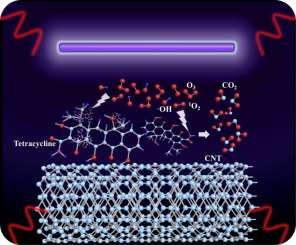Chemical Engineering Journal ( IF 15.1 ) Pub Date : 2020-03-20 , DOI: 10.1016/j.cej.2020.124752 Bei Liu , Yanlong Sun , Tong Zheng , Xu He , Peng Wang , Jing Wang

|
Regeneration of spent CNT is one of the most significant steps but usually be neglected in the adsorption application. In this study, microwave ultraviolet (MW-UV) system was applied to regenerate spent CNT and further degrade the desorbed tetracycline simultaneously. Both regeneration and mineralization ratios were detected to evaluate the regeneration performance. And they ascended with the increment of microwave power as well as regeneration time. Adsorption capacity of spent CNT recovered to 100 %, and 37 % of tetracycline was mineralized to carbon dioxide at 500 W for 2.5 min. High total gas flow rate demonstrated neglected impact on mineralization ratio. After 5 adsorption-regeneration cycles, regeneration and mineralization ratios kept at approximately 80 % and 27 %, respectively, while BET surface area went up. Three kinds of reactive oxygen species (ROS) including ozone, hydroxyl (·OH) radicals and singlet oxygen (1O2) were detected during the regeneration. Ozone concentration declined with the enhancing CNT mass, total gas flow rate as well as relative humidity. A possible tetracycline degradation pathway under MW-UV irradiation was proposed according to the tetracycline structure, ROS chemistry and 11 by-products identified by Ultra High Performance Liquid Chromatography-Mass Spectrometry (UPLC-MS). Conclusively, our research provides new perspective into recycling and reusing spent CNT.
中文翻译:

微波-紫外线法再生四环素饱和的碳纳米管:性能和降解途径
废碳纳米管的再生是最重要的步骤之一,但在吸附应用中通常被忽略。在这项研究中,微波紫外线(MW-UV)系统用于再生废碳纳米管,并同时进一步降解解吸的四环素。检测再生率和矿化率以评估再生性能。并且随着微波功率的增加以及再生时间的增加而上升。用过的CNT的吸附能力恢复到100%,并且在500 W下将37%的四环素矿化为二氧化碳2.5分钟。较高的总气体流速对矿化率的影响被忽略。经过5个吸附-再生循环,再生和矿化率分别保持在80%和27%,而BET表面积却增加了。在再生期间检测到1 O 2)。臭氧浓度随CNT质量,总气体流速以及相对湿度的增加而下降。根据四环素的结构,ROS化学性质和超高效液相色谱-质谱法(UPLC-MS)鉴定出的11种副产物,提出了一种可能的MW-UV辐射下的四环素降解途径。最终,我们的研究为回收和再利用用过的CNT提供了新的视角。


























 京公网安备 11010802027423号
京公网安备 11010802027423号